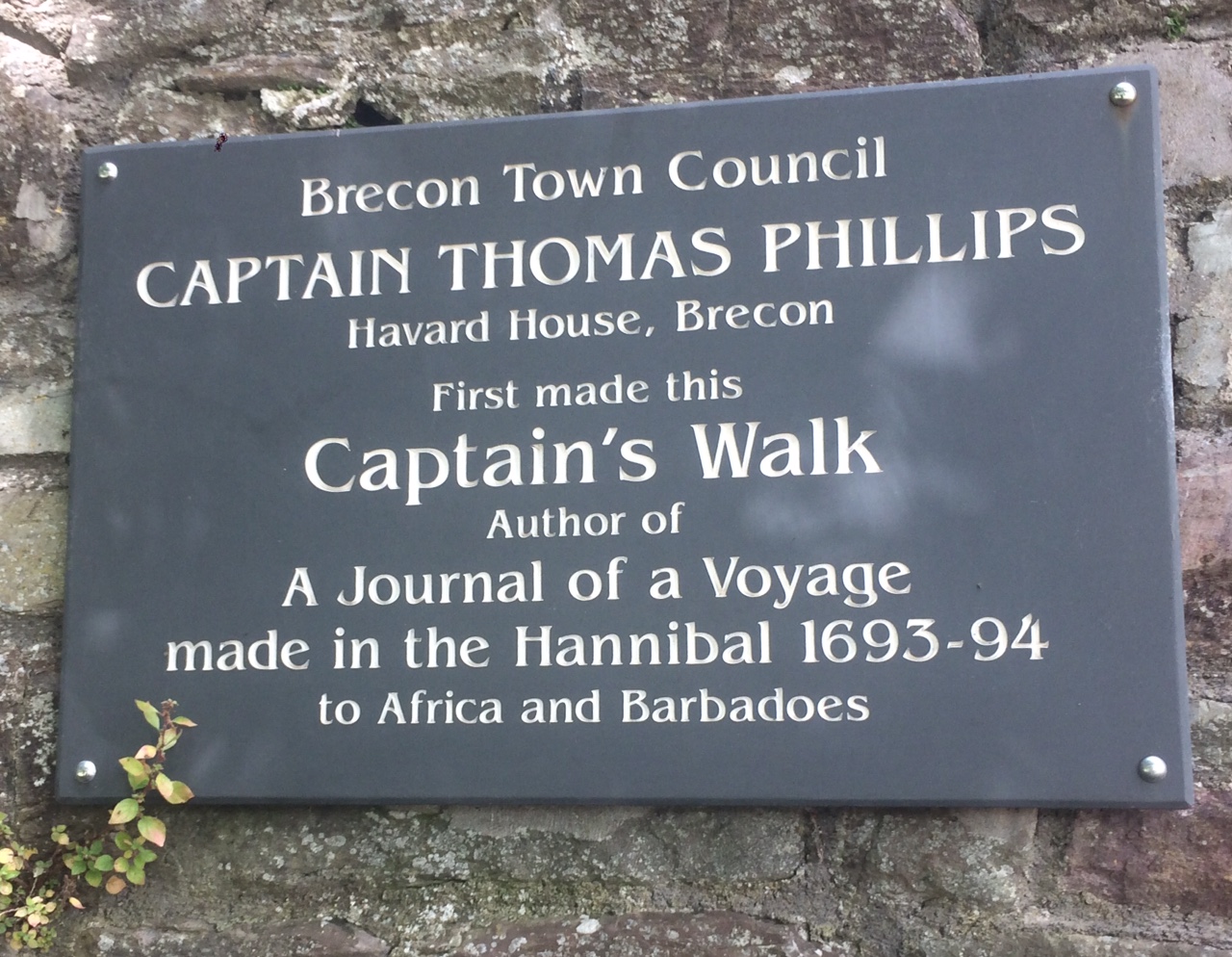
In the Welsh town of Brecon, upon an old wall, along Captains Walk (a name based on a fiction), is a slate plaque commemorating the life of a slave trader who resided in the town. The plaque was commissioned by Brecon Town Councillors in 2009, erected in October 2010 (during Black History Month), and makes no reference to the fact that Captain Phillips was a 17th century slaver.
Captain Thomas Phillips was the commander of the infamous slave ship the Hannibal in the 1690s. He was directly responsible for the tragic deaths of 328 of the 700 enslaved African women, men and children on board, along with 18 of his crew. A very large number of people died in the cruellest of ways including being thrown overboard while still alive to be eaten by sharks. Phillips was deeply involved in the slave trade, through which he had hoped to make a great deal of personal wealth by selling his human cargo. Their suffering was of little or no consequence to Phillips. In his published journal he appears to attempt to offer a sort of reasoning to justify his cruelty based on the detail that black enslaved people were heathens and as such were a lower caste than Christians. Read the full article here.
Following BRHG member Rosemary Caldicott’s letter writing campaign asking for the removal of the plaque and an interview with the editor of the Brecon and Radnor Express, key questions were asked of Brecon Town Council. Caldicott stated:
I think the council has an ethical duty to provide further information with the correct history of what happened on the voyage of the Hannibal, and that could be done really easily, or if they are not able to do that the plaque should be removed.
The council were asked to state their moral and ethical position regarding their decision to erect a plaque to a slave trader that was paid for by Brecon rate payers. The council met on 27 January 2020 (ironically Holocaust Memorial Day) to discuss public concerns and to clarify their position on what should be done about the plaque. The key questions being asked were why they had chosen to commemorate the life of the slave trader Captain Thomas Phillips in the first place? And, who is the plaque for? Unfortunately at the council meeting that followed councillors failed to give viable answers to these fundamental questions. The council voted by 10 to 4 to refer the decision to a ‘subcommittee’ and they rejected the idea of removing the plaque. Several Councillors defended Phillips on the basis of his ancestral links with Welsh Kings! Four councillors stated that the plaque should be removed.
It is paramount that the council do not ignore local and national feelings surrounding the misinformation and offensive nature of the plaque. As yet the council is still validating the erection of the plaque and these questions remain unanswered:
- Why was the plaque commissioned in the first place?
- Who is the plaque for?
- Should the plaque remain with a history interpretation board?
- Who should decide the plaque’s future? 14 councillors or the residents of Brecon who funded the plaque?
If you feel strongly about the continued public display of a plaque to a slave trader and its misleading interpretation you can write to the council directly at email: office@brecontowncouncil.org.uk or write to Brecon Town Council Offices, The Guildhall, Brecon Powys LD3 7AL.
Letters can also be sent to the Brecon and Radnor Express at twm@brecon-radnor.co.uk
As one resident of Brecon recently stated in a letter to the paper:
The only way to send a clear message, especially to our children and grandchildren, that Brecon Town Council on behalf of all residents, utterly condemn past, present and future slavery of any kind is to remove the plaque.
Chris Lawson
This is a no-brainer. Just remove the plaque. It looks like it’s just screwed into the wall so it should be a 2 minute job.
Brecon Resident
I walked past the spot yesterday evening and noticed the plaque has been removed.
Randell Brantley
Thank you for the update.
Brecon Resident 2
Still no answers on the following;
Why was the plaque commissioned in the first place?
Who is the plaque for?
Should the plaque remain with a history interpretation board?
Who should decide the plaque’s future? 14 councillors or the residents of Brecon who funded the plaque?
Johnny Duke
The overriding feeling I get from reading this article and others of a similar vein is that once a decision is made by these low level local dignitaries it is almost impossible to get them to amend it or even justify why they shouldn’t.
Had this plaque been amended to show the full story it would have usefully served as yet another morsel of information for the benefit of everyone.
History, like nature, is red in tooth and claw.
Ian Lloyd
Perhaps it would have been more productive and informative to add an explanation of his involvement and the fact that slavery was accepted by many in that period of history. It could also refer to the fact that it took many, many years for William Wilberforce and others to campaign against slavery until it was abolished. Sometimes, fortunately we do learn from history. If we ignore history and don’t mention it because it is horrific do we one day run the risk of repeating it.
Leaving the plaque there could be an opportunity to explain how the horrific and evil practice of slavery is unacceptable in any form.